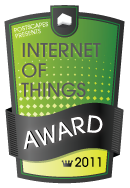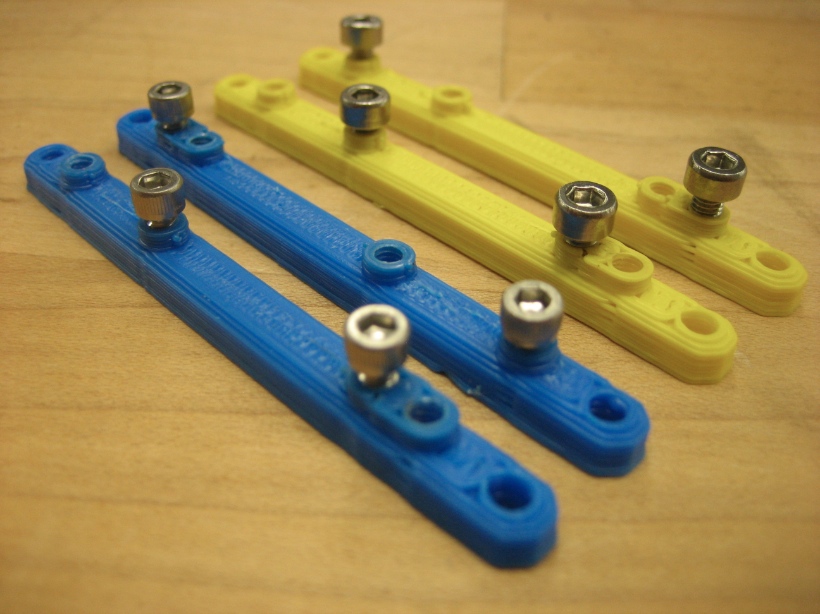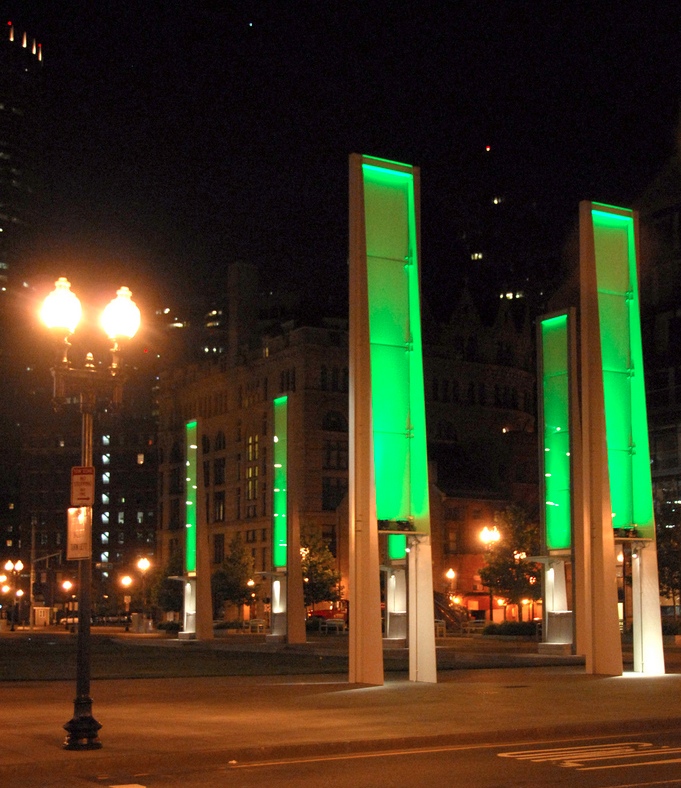
January 17, 2012
The first production Rascals sell out, plus some Color Kinetics action
The first production run of 15 Rascals sold out a few days ago. Thanks to all of you who bought them-- the revenue will go directly back into making the next run.
The next batch of Rascals will be nearly identical to the previous batch. The hardware changes are:
- Added second USB host port and stacked USB connector
- Cheaper, newer, less power-hungry Ethernet controller (Micrel KSZ8051RNL)
- Moved the I2C/TWI pins to the Arduino-compatible location
- Added I2S port for streaming audio
- Changed JTAG and serial debug footprints to work with pogo pins more easily
The software will also be improved for the next batch, in part thanks to the people who have been tweaking the code on their Rascals. The editor will have some new features and the set of tested libraries on the Rascal will be much larger. Because the hardware changes are minor, it's likely that the new software will run fine on old Rascals.
The next batch will be delayed because of Chinese New Year, which runs from January 20 - February 5 this year. In the meantime, if you're interested in buying a Rascal, sign up for the announcement list to get alerted when they're ready.
Making the Rascal work with Color Kinetics lights
Most of my time has been devoted to PCB layout, but I've also been working on some Rascal-controlled light displays around Boston with a group of public artists operating out of Artisan's Asylum. Dan Taub of CEMMI was kind enough to lend me a Color Kinetics light for testing. I've been using a Python library written by Giles Hall that wraps DMX512 data in UDP packets using the KiNet protocol. I created a quick demo page consisting of a color picker on a web page. You pick a color and the Rascal tells the light to turn that color.
Here's a short video that shows the demo in action. If you happen to be on Artisan's Asylum's wireless network, you're welcome to test it out yourself-- just look for the light near the Rascal Micro space (#16).
January 05, 2012
Rascal wins Editors' Choice, now with an interview!

The Rascal won the Editors' Choice award in the Open Source Project category at Postscapes a few days ago. Postscapes is a site in South Korea that tracks the "internet of things," which means stuff like the Rascal, more or less. In the aftermath of the contest, Trevor Harwood of Postscapes and I recorded a discussion of the various topics related to connecting stuff to the internet, open source hardware, and the Rascal. Trevor was kind enough to transcribe and discretize the discussion so you can absorb it in palatable chunks.
Read/listen to the interview.
A brief rant about firewalls and port forwarding
One topic that I had meant to discuss, but forgot about in the heat of battle, is the growing asymmetry of internet connections as the industry matures. The original design of the internet made each computer on the network equal to every other. At least in the US, this is no longer the case. Most incoming connections to our homes and businesses are filtered to prevent people from running their own servers.
Instead of assigning unique addresses to each computer, we use what's called "Network Address Translation," which allows each connection to build its own network behind a firewall, while masquerading as a single computer to the rest of the internet. This works pretty well for surfing the web, but when you want to take off the mask to build the internet of things, it's a problem. Additionally, some connections are filter out incoming requests to ports 80 (HTTP) and 25 (email). This is the case for the least-of-evils, at-least-they're-not-Comcast cable connection from RCN I have at home.
In theory, you can request a block of IP addresses from the American Registry of Internet Numbers, but the minimum fee for IP addresses is $1250, plus various fees for other details (registration and maintenance of an Autonomous System number and such) and ARIN won't give you addresses without a convincing explanation of why you need them. Even if they relented, you'd still need to pay someone who owns a bunch of telephone poles to run a wire from your house to your local internet exchange or negotiate some kind of deal with the local government to allow you to run the cable yourself.
There are a few workarounds that you can use. If you have control of your router, you can pick a few external ports that aren't blocked by your ISP and forward them to devices on your internal network. If you live in a big apartment building where all you get is wireless access, this won't work unless your landlord likes you a lot and nobody else wants to fight you for those ports. The other option is creating encrypted software tunnels to external servers, but that requires either that you run a server yourself or get access from someone who does.
Anyway, it's a bit of a mess. I wish I had more ideas about how to fix the situation, but I don't. I wish I had grown up in the good old days, when men were men and IP addresses were globally routed.
December 23, 2011
3D printed Rascal base with tapped holes
If you want to mount the Rascal in a metal enclosure, you need a way to hold the board away from the enclosure, so the electronics don't get shorted out. For most of the history of electronics, this sort of task has been accomplished using small, annoying posts called "standoffs." They work, but they're more expensive and fiddly than you'd like.
Now that consumer-grade 3D printers like the Makerbot Thing-O-Matic are available, printing custom brackets to hold your circuit board is plausible. I've taken a first cut at the design and uploaded the source files to Thingiverse. If you'd like some brackets for your Rascal and you have access to a 3D printer, you're welcome to download the files and print out some brackets. The print time is around 8 minutes per bracket. They'll work with either #4-40 or M3 fasteners. If you're not sure, use M3 because the metric system is better.
If you'd like to try this out, but you can't find a 3D printer, you might try checking with your local hackerspace, which you can find on the Hackerspaces.org map.

Drilling and tapping 3D printed brackets
The holes in the brackets won't have threads in them straight out of the printer. To make threads in the plastic, you need to drill out the holes to the right diameter and then use a tap to cut the threads.
It would be nice if you didn't need to predrill the holes before tapping. In the model, the holes are set to 2.26 mm in diameter, which theoretically shouldn't need predrilling, but with parts printed on my local Thingomatic, the actual diameter was smaller, so predrilling was required.
M3 fasteners
For M3 fasteners, I use a 0.100" drill (AKA drill size #39). You could certainly use a 2.5 mm drill. I suspect that a 3/32" drill would also work. For mounting the Rascal, a M3 x 6 stainless steel socket head cap screw, such as McMaster part number 91292A111, works great.
#4-40 fasteners
For #4-40 fasteners, I use a 0.089" drill (AKA drill size #43). I suspect that a 3/32" drill would also work. For mounting the Rascal, a #4-40 x 1/4" stainless steel socket head cap screw, such as McMaster part number 92196A106, works great.
December 02, 2011
Testing the Rascal with the Greenway light blades
Here's a low quality video of a truly excellent event.
I'm working on a project to control the light blades on the Greenway in Boston through text messages. While I was filming the video with my phone, Dan was crouched in "The Vault," a concrete bunker under the Greenway plaza. We had a Rascal plugged into the light controller with a serial cable. Dan used a Python script I wrote to generate HTTP POSTs on my laptop. In theory, the POSTs are the same requests that we'll eventually receive from Twilio. (See this Rascal-and-Twilio tutorial for the details on how that works.) The Rascal parses the messages Dan sends and decides what show to play. The shows are still a bit of a mess, but the Rascal is working great.
I don't want to say too much more about what we have planned until it's closer to fruition, but I think it will be cool.
Below is a better still shot from Eric Kilby that gives a better idea of what the light blades look like in person. There are 12 of them in all; they're in the park between Faneuil Hall and the Aquarium.

older postsnewer posts



